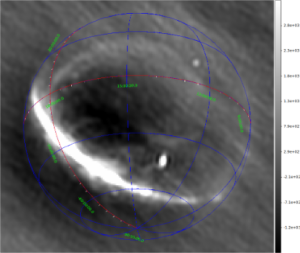Project area/S
- Transient Universe : fast radio bursts (FRBs), pulsars, radio transients
Project Details

Example 2-second image of the entire visible hemisphere at 160 MHz obtained with the SKA-Low prototype station EDA2
Fast Radio Bursts (FRB) are one of the most fascinating transient phenomena discovered only 15 years ago. Recent localisations and redshift measurements of several FRBs confirmed their extra-galactic origin and extreme energies of the order of 1039 ergs, which are emitted over milli-second intervals. However, full understanding of FRB sources and underlying physical mechanisms powering these extreme events still awaits full explanation. Originally FRBs were discovered at frequencies around 1.4 GHz. However, multiple detections by CHIME telescope extending down to 400 MHz, LOFAR detections of repeating FRB 20180916B down to 110 MHz, and Green Bank Telescope discovery of FRB 20200125A at 350 MHz demonstrate that there exists a population of FRBs, which can be detected at frequencies below 350 MHz.
Stations of the low-frequency Square Kilometre Array (SKA-Low) telescope, which is currently being built at the Murchison Radio-astronomy Observatory in Western Australia, open a unique possibility of all-sky FRB survey. Predictions based on data from other higher frequency instruments show that just a single station of SKA-Low can detect even hundreds of FRBs per year in all-sky images. Hence, the main goal of this summer project is to perform a pilot FRB search using around 24 hours of 100ms all-sky images from one of the existing SKA-Low prototype stations, the Engineering Development Array 2 (EDA2) and try to detect low-frequency FRBs. Even if FRBs cannot be detected due to limited capabilities of the current system, it should be possible to derive a competitive upper limit on FRB rate at these frequencies and compare it with other results in literature. Moreover, we may be able to detect pulses from other astrophysical and non-astrophysical sources and characterise the background events for this kind of searches (including various sources of radio-frequency interference (RFI)).
Student Attributes
Academic Background
Programming in scripting languages (bash and python). It may be sufficient if the student is proficient in programming in some other language and can quickly learn python.
Astronomy/astrophysics background will be useful, but is not critical for this project.
Computing Skills
Python, bash scripting, Linux environment
Programming in C/C++ can be very advantageous too.
Training Requirement
Introduction to HPC computing. If the candidate does not know python some basic training will be useful too.
Project Timeline
| Week 1 | Inductions and project introduction |
| Week 2 | Initial presentation |
| Week 3 | Get familiar with the data (all-sky images and dynamic spectra from EDA2) and processing software. Execute the processing software on a small portion (few minutes) of data to form dynamic spectra and de-dispersed time series. Verify that the results are correct and make physical sense before proceeding with the analysis of more data. |
| Week 4 | Process 1 hour of EDA2 all-sky images, to produce dynamic spectra and de-dispersed time series. Once results are verified and look as expected, proceed to processing a few hours worth of all-sky images. In order to gain basic understanding of the results, perform basic statistical analysis of the identified FRB candidates, for example: number of candidates per 10 min worth of data, distribution of their signal-to-noise (SNR) etc. The list of statistical checks will be decided later. |
| Week 5 | Process about 24 hours worth of EDA2 all-sky images. Perform statistical analysis on the full dataset to gain basic understanding of the number of candidates etc. Identify various classes of background, and design filtering criteria (machine learning can be considered) to excise them, while leaving the most promising and significant (high SNR) candidates for events of astrophysical origin (FRBs, pulsars, magnetars etc). The most common classes of background events may be: radio-frequency interference (RFI), noise, satellites/planes, astrophysical etc. |
| Week 6 | Implement the designed filtering criteria to excise the most typical classes of background events and identify the most promising and significant (high SNR) candidates of astrophysical origin (FRBs, pulsars, magnetars etc). Develop a reasonably fast procedure of inspecting candidates. |
| Week 7 | Continue with development of filtering and verification of the identified candidates, and iteratively improve the classification criteria. In the end narrow down the list of astrophysical candidates to a short list of 10 – 20 candidates for a more detail inspection. |
| Week 8 | Critically evaluate the short list of candidates, and verify if any of them are due to known bright pulsars (like B0950+08), other radio sources, can be matched to known satellites, other sources of RFI or are of unknown origin. Is there a genuine FRB candidate in the dataset ? If no, derive an upper limit on the FRB rate at the particular observing frequency, and at a given limiting fluence (based on the sensitivity of EDA2 station). |
| Week 9 | Final presentation |
| Week 10 | Final report |